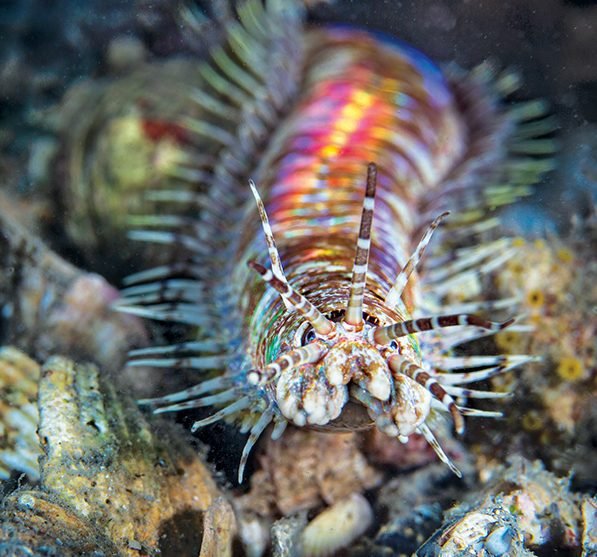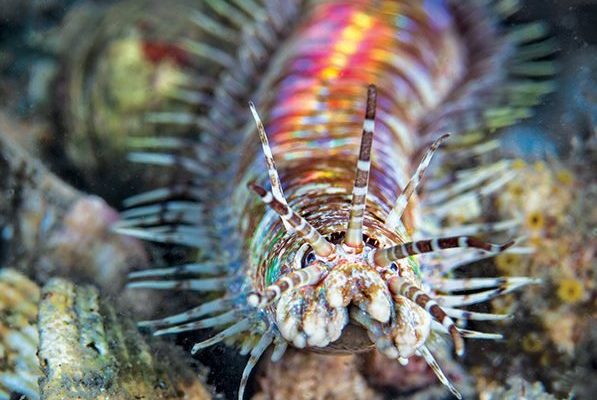
Let’s imagine you’re at your favorite aquarium, sipping a cup of coffee while watching a mesmerizing display of underwater life. Suddenly, you notice a long, segmented worm peeking out from the sand. It might look a bit like a creature from a sci-fi movie, but that’s just the Bobbit worm doing its thing. Handling and displaying these creatures properly is essential, and understanding their behavior can enhance the experience for both aquarists and visitors alike.
What Are Bobbit Worms?
Bobbit worms, scientifically known as *Eunice aphroditois*, are fascinating marine polychaetes that can grow up to 10 feet long! They’re named after the infamous incident involving John Wayne Bobbitt, where the term “Bobbit” has become synonymous with things that bite back. And yes, these worms can deliver a pretty nasty sting if disturbed, so caution is crucial when handling them.
These worms live in burrows they create in sandy or muddy substrates, where they wait patiently for unsuspecting prey to swim by. Using their specialized jaws, they can launch out of their burrow to snag fish and other small creatures. This hunting strategy makes them effective predators in their natural habitats, which typically include coral reefs and rocky areas.
When displayed in public aquariums, it’s important to recreate their natural habitat as closely as possible. This includes providing plenty of hiding spots, such as rocks and substrate, to ensure they feel secure. People often find these worms captivating, so knowing how to set up a suitable display will enhance the visitor experience.
Handling Bobbit Worms Safely
Honestly, if you ever find yourself needing to handle a Bobbit worm, proceed with caution. These creatures may be mesmerizing, but they’re not pets you want to mess with. Their powerful jaws can inflict painful bites, so understanding proper handling techniques is essential.
Here are some tips for handling Bobbit worms safely:
- Use gloves: Always wear protective gloves to avoid direct contact with the worm.
- Minimize disturbance: Try not to disturb their habitat unnecessarily. If you need to move them, do so gently.
- Use tools: Consider using long-handled tools to help manipulate or move the worm without risking a bite.
Here’s the thing: if you’re in a public aquarium, the staff is usually well-trained on how to handle these fascinating creatures. They’ve got protocols and safety measures in place, so it’s best to let the professionals do their job. If you’re ever curious or have questions, don’t hesitate to ask the staff!
Creating a Display Environment for Bobbit Worms
When it comes to displaying Bobbit worms in an aquarium, the environment is key. These creatures thrive in setups that mimic their natural habitats. Here’s how to get started:
1. **Substrate**: Use fine sand or a mixture of sand and gravel to allow the worms to burrow. This will help them feel secure and reduce stress.
2. **Hiding Spots**: Incorporate rocks, coral, and other structures to create hiding spots. Bobbit worms are shy and prefer to stay out of sight most of the time.
3. **Water Quality**: Maintaining excellent water quality is essential. Use a good filtration system and regularly test the parameters (like pH, salinity, and temperature) to make sure everything is optimal.
4. **Feeding**: Bobbit worms are carnivorous, so providing live food like small fish or shrimp can keep them happy. However, make sure to feed them appropriately to prevent overfeeding.
By recreating their natural environment as closely as possible, you’ll not only keep your Bobbit worms healthy but also provide an engaging experience for visitors.
Visitor Engagement and Education
When public aquariums display Bobbit worms, they unlock a fantastic opportunity for educational engagement. These creatures can spark curiosity and lead to fascinating discussions about marine life, relationships within ecosystems, and the importance of biodiversity.
To enhance visitor engagement, consider these strategies:
- Informational Signage: Display signs near the tank that highlight interesting facts about Bobbit worms. This could include information about their feeding habits, habitat, and role in the ecosystem.
- Interactive Displays: Use interactive screens or QR codes that visitors can scan to learn more or watch videos about Bobbit worms in their natural habitat.
- Guided Tours: Offer guided tours focused on fascinating marine creatures, including Bobbit worms, to provide visitors with deeper insights.
By creating a knowledgeable environment, aquariums can turn an encounter with a Bobbit worm into an educational adventure. You might be surprised at how such a unique creature can inspire awe and wonder!
Challenges in Displaying Bobbit Worms
While displaying Bobbit worms can be incredibly rewarding, there are some challenges that aquariums might face. **Behavior** is one of them. Bobbit worms often spend a lot of time hidden, which can be frustrating for visitors hoping to see one actively hunting. To combat this, aquariums can consider using feeding techniques that encourage worms to come out, like scattering food or using feeding tubes to simulate live prey.
Another challenge is **tank mates**. While Bobbit worms can coexist with some species, they might pose a threat to smaller fish. Careful selection of tank mates is crucial to avoid predation. Aquarists should monitor interactions closely to ensure the safety of all inhabitants.
Lastly, maintaining the **right conditions** for these worms can be complex. Regular testing of water parameters, such as temperature and salinity, is essential. A consistent routine can help prevent stress and keep the Bobbit worms healthy.
Bobbit worms are truly fascinating creatures that add a unique element to public aquariums. From their striking appearance to their incredible hunting skills, they capture the imaginations of visitors of all ages. Understanding how to handle and display these creatures effectively not only helps keep them safe but also enhances the experience for everyone who visits.
As aquariums continue to evolve and adapt, showcasing the beauty and intrigue of Bobbit worms offers a chance to educate the public and promote conservation efforts. So next time you visit an aquarium, take a moment to appreciate the hidden wonders of the marine world—like the incredible Bobbit worm peeking out from the sand, waiting for its next meal. It’s a reminder of the complexity and beauty of ocean life, just waiting to be explored!

